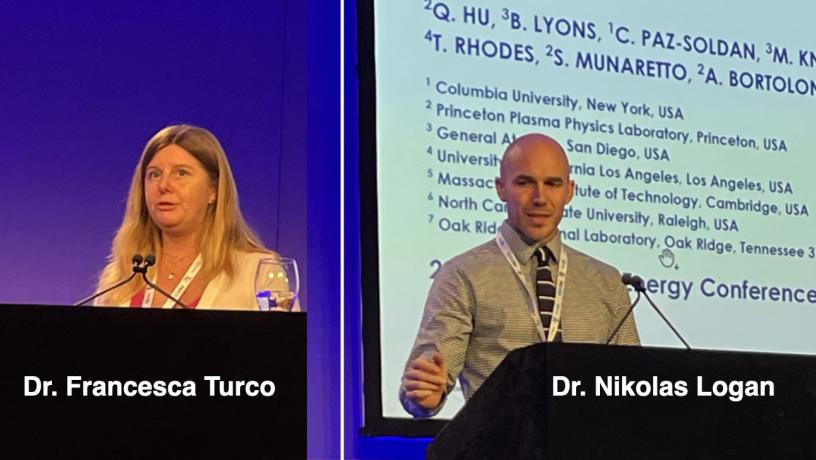Columbia University Scientists Report Research at IAEA Fusion Energy Conference
Last week, Columbia University scientists and alumni were invited to report latest results at the 29th IAEA Fusion Energy Conference (FEC) hosted by the United Kingdom Atomic Energy Authority (UKAEA) in London.
Every two years, the IAEA FEC brings together scientists and engineers from around the world to share fusion research results and highlight worldwide advances in fusion theory, experiments, technology, engineering, materials, advanced concepts, safety, socio-economics and preparation to industrial deployment.
Highlights from this year's meeting included plenary lectures by Columbia University scientists Dr. Francesca Turco and Dr. Nikolas Logan and reports from a growing private sector with launching public-private partnerships to address remaining challenges to the technological feasibility of fusion power for clean sustainable energy.
Dr. Franceca Turco's presentation "First Tungsten radiation studies and non-linear oscillations in DIII-D’s ITER Baseline Demonstration Discharges" reported new experiments at the DIII-D National Tokamak Facility and the first studies of the impact of metallic impurity radiation and transport in planned burning plasma experiments in the ITER device and concluding good understanding of fusion performance with changing levels of metallic impurity.
Dr. Nikolas Logan's presentation "Improved pedestal performance utilizing resonant magnetic perturbations and edge localized electron cyclotron current drive" also reported experiments on the DIII-D tokamak identifying two new ways to operate the tokamak with improved confinement in the presence of resonant magnetic perturbations (RMPs). When the plasma rotates opposite to the direction of plasma current, particles "pump-inward” due to a reduction of turbulent transport. When the plasma rotates in the other direction, Logan and colleagues showed how microwaves can be used to drive local regions of plasma current and gain access to a high temperature edge with super high confinement properties.
This year's conference embraced public-private partnerships for fusion energy development with a special session called "Pathways to fusion." Columbia University alumnus Dr. Brian Grierson (PhD 2009), Director of General Atomics fusion pilot plant project, summarized the design and technology maturation of General Atomics steady-state advanced tokamak fusion pilot plant. Presentations were also made by Dr. Ben Levitt (PhD 2004), VP of Research and Development at Zap Energy, "Path to Commercial Fusion Energy Based on Sheared-Flow-Stabilized Z Pinches" and by Dr. David Gates (PhD 1993), CTO Thea Energy,"Stellarator Fusion Power Plant Enabled by Arrays of Planar Coils."
Several other Columbians were invited to participate and present research summaries. Prof. Carlos Paz-Soldan presented "Equilibrium, Stability, and Disruption Calculations Supporting the Design and Assembly of the SPARC Tokamak," Prof. Mike Mauel represented the work of the HBT-EP Tokamak and graduate student Yumou Wei and presented "Innovations In Detection And Control of Helical Instabilities in Wall-Stablized Tokamak Plasma," Dr. Steve Sabbagh presented "High Accuracy, Multi-Device Physics-Based Tokamak Disruption Prediction and Forecasting With First Real-Time Demonstration," Dr. Jeremy Hanson, reported "Variable-Spectrum Mode Control of High Poloidal Beta Discharges," and Dr. Andrew "Oak" Nelson presented "Robust L-Mode Edge Behavior in High Performance Negative Triangularity Plasmas: From Experiments to Reactors.”

